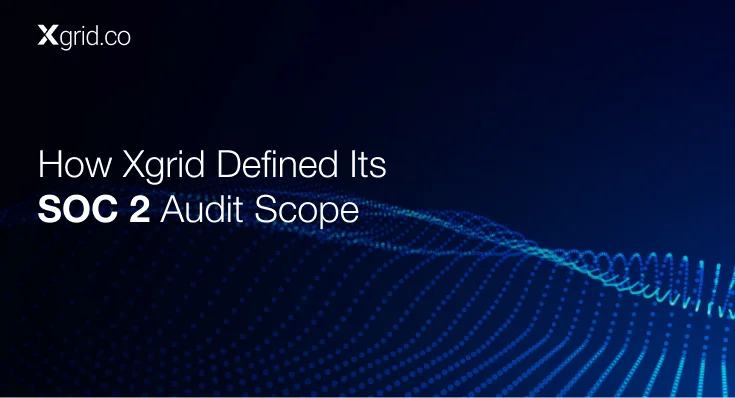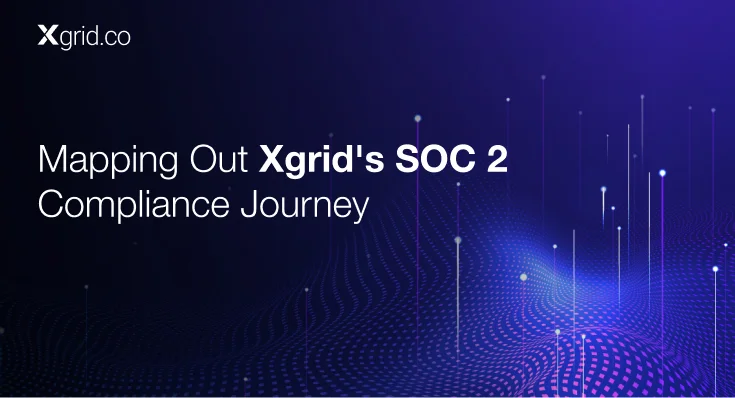Conducting a Readiness Assessment: Xgrid’s Approach
How Xgrid Defined Its SOC 2 Audit Scope
The SOC 2 framework, developed by the American Institute of CPAs (AICPA), focuses on evaluating an organization’s security posture based on five Trust Service Criteria (TSCs): Security, Availability, Processing Integrity, Confidentiality, and Privacy.
One of the most critical steps in this journey was defining the audit scope, and ensuring that all necessary systems, processes, and controls were evaluated. A well-defined scope not only keeps the audit process focused but also ensures that the company meets the expectations of stakeholders and regulators.
In this detailed blog, we’ll walk through how Xgrid approached the challenge of defining its SOC 2 audit scope to ensure a thorough and efficient audit process.
1. Understanding the SOC 2 Audit Scope: Why It Matters
The SOC 2 audit scope defines the boundaries of what will be evaluated during the audit process. Setting the right scope is critical because it impacts the breadth of the audit, the resources required, and the relevance of the final report to Xgrid’s customers. The goal is to ensure that the audit covers all systems and processes that affect the security, availability, and confidentiality of customer data, while avoiding the inclusion of irrelevant parts of the organization.
If the scope is too broad, it can lead to unnecessary complexity, extended timelines, and inflated costs. If it’s too narrow, critical systems or services may be overlooked, which could result in gaps in compliance or vulnerabilities that go undetected. For Xgrid, finding the right balance was essential to create an effective audit process that also addressed the needs of our customers.
Why Defining the Scope is Crucial:
-
-
- Focuses the Audit: Ensures auditors concentrate on critical systems and services that directly impact trust service criteria (TSCs).
- Cost and Time Efficiency: A well-defined scope reduces redundant work, optimizing both audit costs and the time required.
- Customer and Stakeholder Assurance: Ensures that the audit addresses the key systems and processes customers are concerned with.
-
2. Assessing Xgrid’s Business Environment and Operational Boundaries
At the outset of our SOC 2 journey, Xgrid had to take stock of our overall business environment. This included understanding how our customers interacted with our products and services and identifying the key components of our technical infrastructure.
Business Environment Assessment:
-
-
- Products and Services: We analyzed the full suite of cloud-based services we offer, ensuring that customer-facing services were the primary focus of the audit. This included SaaS platforms, API services, and any hosted environments where customer data might be stored or processed.
- Internal Systems: Beyond customer-facing services, we evaluated internal systems that could impact the security or availability of our services. These included access management systems, monitoring tools, and our internal IT infrastructure.
-
Through this assessment, we identified the systems and services that would form the foundation of our audit scope. This understanding allowed us to focus on the areas that mattered most from both a compliance and business continuity perspective.
3. Mapping Xgrid’s Systems and Services to Trust Service Criteria
One of the most important aspects of defining the SOC 2 audit scope was aligning Xgrid’s systems and services with the SOC 2 Trust Service Criteria (TSCs). Each TSC represents a different dimension of system reliability and security, and each system in our scope had to be evaluated according to the criteria that applied.
a) Security
The security principle is the foundation of SOC 2 compliance and applies to all systems in scope. Xgrid’s cloud infrastructure, including AWS and Azure environments, was at the heart of this scope. We evaluated our firewalls, VPNs, multi-factor authentication (MFA) systems, and encryption protocols to ensure unauthorized access to sensitive data is prevented.
Key Components of Security in Scope:
-
-
-
- User Access Controls: Ensuring that only authorized users had access to systems and data.
- Encryption: Protecting data both in transit and at rest using robust encryption mechanisms (e.g., AES-256).
- Firewall Configurations: Ensuring proper segmentation between internal and external networks, preventing unauthorized access.
-
-
b) Availability
As a cloud-based company, ensuring the availability of services was critical. Our customers rely on uninterrupted access to our platforms, so we included systems like load balancers, high-availability (HA) configurations, and disaster recovery (DR) systems in the scope.
Key Components of Availability in Scope:
-
-
-
- Redundancy: Systems for failover and redundancy, ensuring minimal downtime in case of failure.
- Monitoring Tools: Continuous monitoring of service availability, alerting in case of outages or degradation.
- Disaster Recovery Plans: The ability to restore services in case of a major disruption, including DR plans for critical cloud environments.
-
-
c) Processing Integrity
Processing integrity ensures that systems perform their intended functions without errors. In this context, we audited our transactional systems and the data processing workflows that automate critical business functions.
Key Components of Processing Integrity in Scope:
-
-
-
- Data Validation Mechanisms: Ensuring the accuracy and completeness of processed data.
- Automated Workflows: Reviewing systems where automated decision-making occurs (e.g., billing, data aggregation) to confirm that they operate reliably.
- Error Handling: Ensuring that errors are detected and corrected promptly.
-
-
d) Confidentiality
Confidentiality revolves around protecting customer data from unauthorized access or disclosure. Our storage systems, encryption protocols, and access policies were a primary focus here, ensuring that sensitive customer data is handled with the utmost care.
Key Components of Confidentiality in Scope:
-
-
-
- Data Encryption: Both at rest and in transit to ensure that customer data remains confidential.
- Access Controls: Role-based access controls (RBAC) to limit access to sensitive data to only those employees or systems that need it.
- Data Retention Policies: Ensuring that we only retain customer data for as long as necessary, securely deleting it afterward.
-
-
e) Privacy
The privacy principle is particularly relevant when handling personally identifiable information (PII) or other sensitive data. Although not all Xgrid services handle PII, where applicable, we evaluated our privacy policies and practices.
Key Components of Privacy in Scope:
-
-
-
- Data Collection Practices: Ensuring that we only collect the data necessary for business purposes.
- User Consent and Rights: Evaluating how customers are informed about their data rights and how consent is obtained.
- Data Access Requests: Policies for handling customer requests to access, modify, or delete their data.
-
-
4. Defining the Boundaries: Internal and Third-Party Systems
Xgrid, like many organizations, relies on third-party vendors for cloud hosting, data storage, and other auxiliary services. These external services formed a critical part of our SOC 2 scope since they directly influence our ability to meet trust service criteria.
We approached this by defining the boundaries between internal systems managed by Xgrid and third-party systems managed by vendors.
a) Internal Systems
The systems we manage directly, including our own data centers and in-house developed software, were clearly part of the audit scope. We reviewed and audited the full spectrum of security and operational controls over these systems, ensuring that they align with our SOC 2 requirements.
b) Third-Party Vendors
Third-party services presented a different challenge. To address this, we reviewed their own SOC reports and security certifications. For critical vendors (e.g., AWS, Azure), we ensured their services met our stringent security and availability requirements by analyzing their controls, reviewing Service Level Agreements (SLAs), and conducting independent assessments where necessary.
Vendor Risk Management in Scope:
-
-
- Vendor SOC Reports: Xgrid required and reviewed SOC 2 reports from all key vendors, ensuring they maintain adequate security practices.
- Contractual Agreements: SLAs were scrutinized to ensure vendors were contractually obligated to maintain high levels of availability and security.
- Ongoing Vendor Audits: Continuous monitoring of vendor performance and security through periodic assessments and reviews.
-
5. Involving Key Stakeholders in Scope Definition
SOC 2 compliance isn’t just an IT or security function—it involves the entire organization. To ensure our scope was both comprehensive and manageable, we brought in a wide range of stakeholders from across Xgrid, including IT, legal, compliance, and business operations teams.
a) Risk Assessments
To identify which systems and services posed the most significant risks, Xgrid performed a detailed risk assessment. This assessment evaluated potential threats to security, availability, confidentiality, and privacy, ensuring that the scope addressed the most critical areas.
b) Workshops and Cross-Functional Collaboration
We conducted workshops with various teams to gather input on the systems, processes, and controls that should be included in the audit scope. Each department brought its expertise, ensuring that all relevant areas were covered.
c) Customer Expectations and Feedback
Our customers’ needs also played a significant role in scope definition. Through feedback sessions and surveys, we identified key concerns and expectations regarding the security and reliability of our services, incorporating these into the final scope.
6. Maintaining Flexibility: Continuous Scope Refinement
Finally, we recognized that our SOC 2 audit scope would need to evolve over time. As Xgrid introduces new services or platforms, or as the security landscape changes, we’ll need to continuously refine our audit scope to remain compliant and meet customer expectations.
a) Ongoing Risk Assessments
Annual risk assessments ensure that any new or emerging risks are identified and incorporated into the audit scope. This ensures our scope remains relevant and responsive to the changing security landscape.
b) Customer and Industry Feedback
We regularly engage with customers and industry experts to ensure that our scope reflects the latest expectations in cybersecurity and data protection.
c) Internal Audits
Periodic internal audits allow us to evaluate the effectiveness of our controls and the adequacy of our scope. These audits help ensure continuous improvement in our SOC 2 compliance program.
Conclusion
Defining the scope of Xgrid’s SOC 2 audit was a strategic process that involved assessing our business environment, mapping systems to trust service criteria, evaluating third-party vendors, and involving stakeholders. By aligning the audit scope with business objectives and customer expectations, we ensured that the audit was both comprehensive and efficient. As we continue to grow, we’ll maintain a flexible and adaptive approach to scope definition, ensuring ongoing compliance with SOC 2 standards.
Stay tuned for the next chapter of Xgrid’s SOC 2 journey, where we’ll explore how we implemented and tested key security controls across our infrastructure.

Established in 2012, Xgrid has a history of delivering a wide range of intelligent and secure cloud infrastructure, user interface and user experience solutions. Our strength lies in our team and its ability to deliver end-to-end solutions using cutting edge technologies.
OFFICE ADDRESS
US Address:
Plug and Play Tech Center, 440 N Wolfe Rd, Sunnyvale, CA 94085
Dubai Address:
Dubai Silicon Oasis, DDP, Building A1, Dubai, United Arab Emirates
Pakistan Address:
Xgrid Solutions (Private) Limited, Bldg 96, GCC-11, Civic Center, Gulberg Greens, Islamabad
Xgrid Solutions (Pvt) Ltd, Daftarkhwan (One), Building #254/1, Sector G, Phase 5, DHA, Lahore




